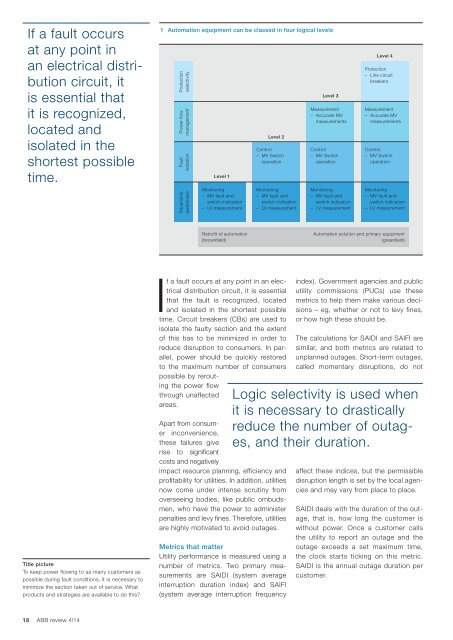ABB Review 4-2014_72dpi
ABB Review 4-2014_72dpi
ABB Review 4-2014_72dpi
Create successful ePaper yourself
Turn your PDF publications into a flip-book with our unique Google optimized e-Paper software.
If a fault occurs<br />
at any point in<br />
an electrical distribution<br />
circuit, it<br />
is essential that<br />
it is recognized,<br />
located and<br />
isolated in the<br />
shortest possible<br />
time.<br />
1 Automation equipment can be classed in four logical levels<br />
Protection<br />
selectivity<br />
Power flow<br />
management<br />
Fault<br />
isolation<br />
Situational<br />
awareness<br />
Level 1<br />
Monitoring<br />
– MV fault and<br />
switch indication<br />
– LV measurement<br />
Level 2<br />
Control<br />
– MV Switch<br />
operation<br />
Monitoring<br />
– MV fault and<br />
switch indication<br />
– LV measurement<br />
Level 3<br />
Measurement<br />
– Accurate MV<br />
measurements<br />
Control<br />
– MV Switch<br />
operation<br />
Monitoring<br />
– MV fault and<br />
switch indication<br />
– LV measurement<br />
Level 4<br />
Protection<br />
– Line circuit<br />
breakers<br />
Measurement<br />
– Accurate MV<br />
measurements<br />
Control<br />
– MV Switch<br />
operation<br />
Monitoring<br />
– MV fault and<br />
switch indication<br />
– LV measurement<br />
Retrofit of automation<br />
(brownfield)<br />
Automation solution and primary equipment<br />
(greenfield)<br />
Title picture<br />
To keep power flowing to as many customers as<br />
possible during fault conditions, it is necessary to<br />
minimize the section taken out of service. What<br />
products and strategies are available to do this<br />
If a fault occurs at any point in an electrical<br />
distribution circuit, it is essential<br />
that the fault is recognized, located<br />
and isolated in the shortest possible<br />
time. Circuit breakers (CBs) are used to<br />
isolate the faulty section and the extent<br />
of this has to be minimized in order to<br />
reduce disruption to consumers. In parallel,<br />
power should be quickly restored<br />
to the maximum number of consumers<br />
possible by rerouting<br />
the power flow<br />
through unaffected<br />
areas.<br />
Apart from consumer<br />
inconvenience,<br />
these failures give<br />
rise to significant<br />
costs and negatively<br />
impact resource planning, efficiency and<br />
profitability for utilities. In addition, utilities<br />
now come under intense scrutiny from<br />
overseeing bodies, like public ombudsmen,<br />
who have the power to administer<br />
penalties and levy fines. Therefore, utilities<br />
are highly motivated to avoid outages.<br />
Metrics that matter<br />
Utility performance is measured using a<br />
number of metrics. Two primary measurements<br />
are SAIDI (system average<br />
interruption duration index) and SAIFI<br />
(system average interruption frequency<br />
index). Government agencies and public<br />
utility commissions (PUCs) use these<br />
metrics to help them make various decisions<br />
– eg, whether or not to levy fines,<br />
or how high these should be.<br />
The calculations for SAIDI and SAIFI are<br />
similar, and both metrics are related to<br />
unplanned outages. Short-term outages,<br />
called momentary disruptions, do not<br />
Logic selectivity is used when<br />
it is necessary to drastically<br />
reduce the number of outages,<br />
and their duration.<br />
affect these indices, but the permissible<br />
disruption length is set by the local agencies<br />
and may vary from place to place.<br />
SAIDI deals with the duration of the outage,<br />
that is, how long the customer is<br />
without power. Once a customer calls<br />
the utility to report an outage and the<br />
outage exceeds a set maximum time,<br />
the clock starts ticking on this metric.<br />
SAIDI is the annual outage duration per<br />
customer.<br />
18 <strong>ABB</strong> review 4|14



